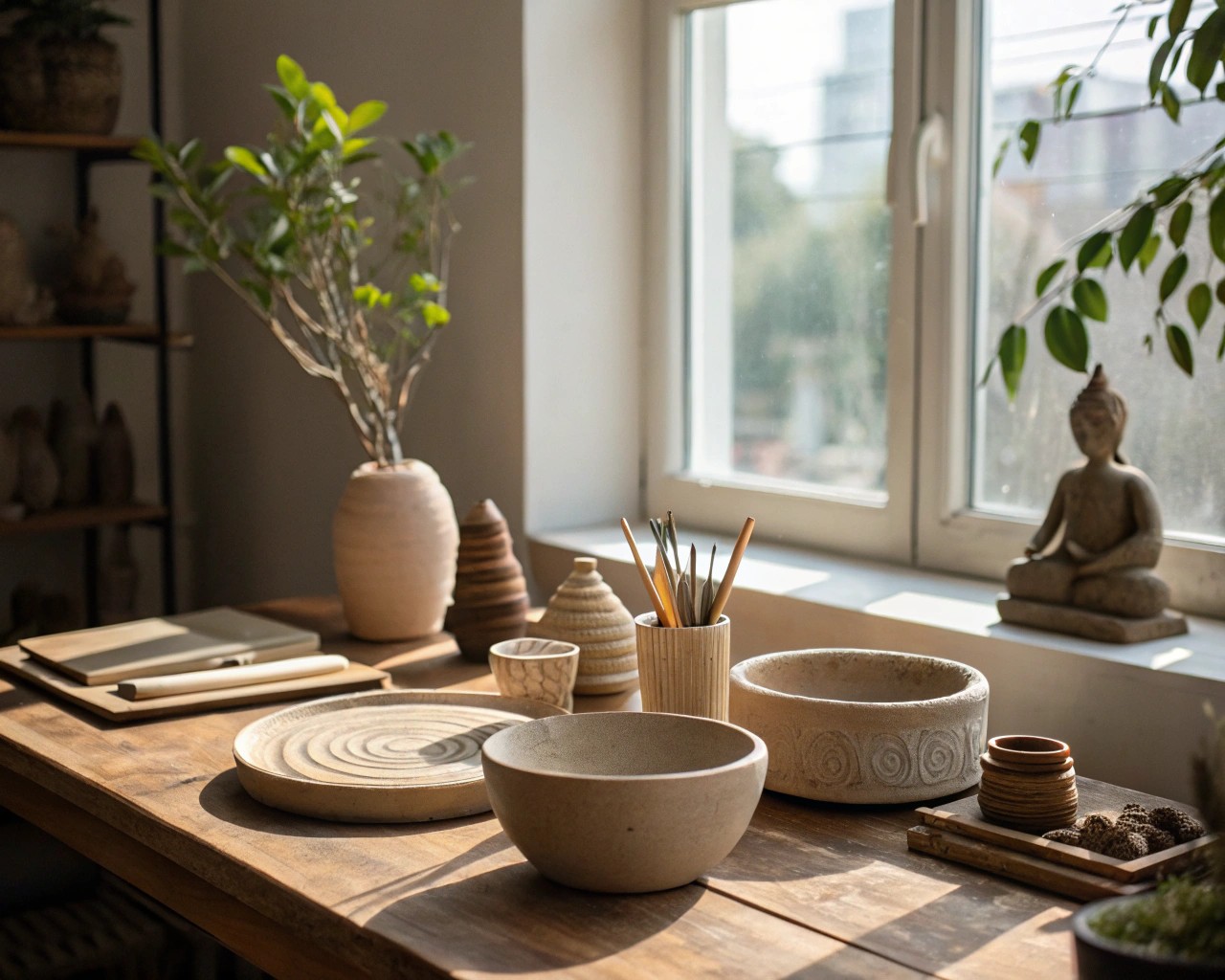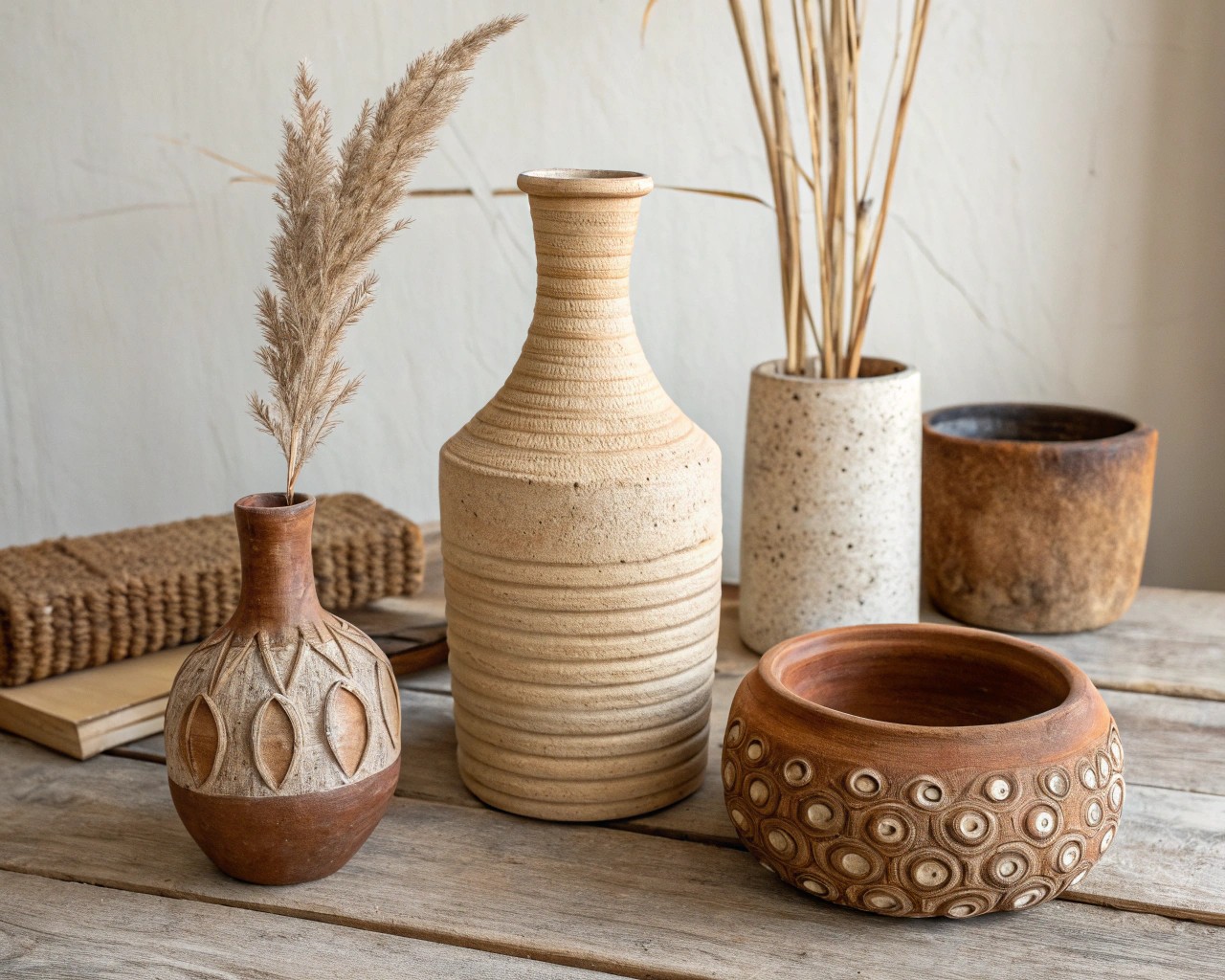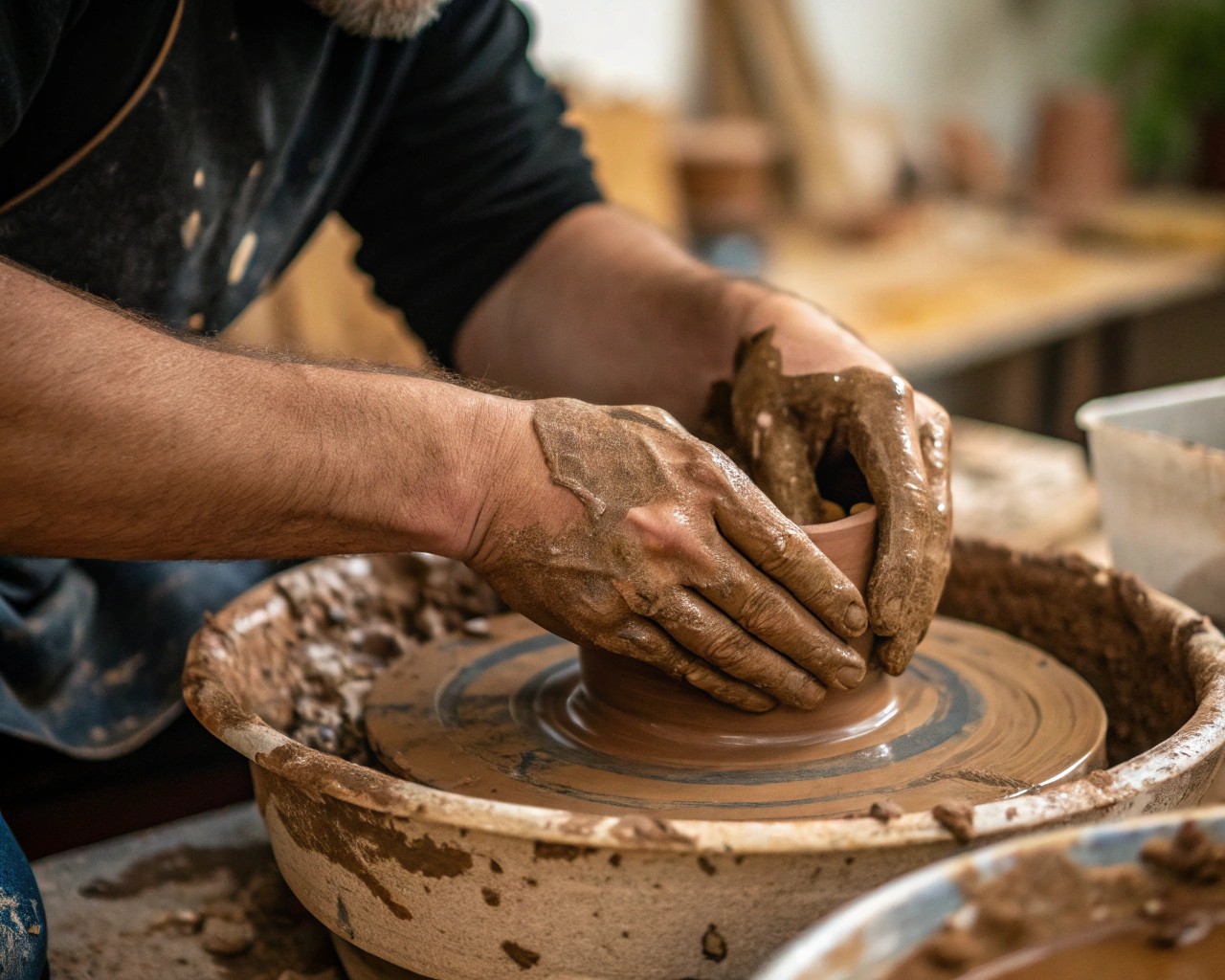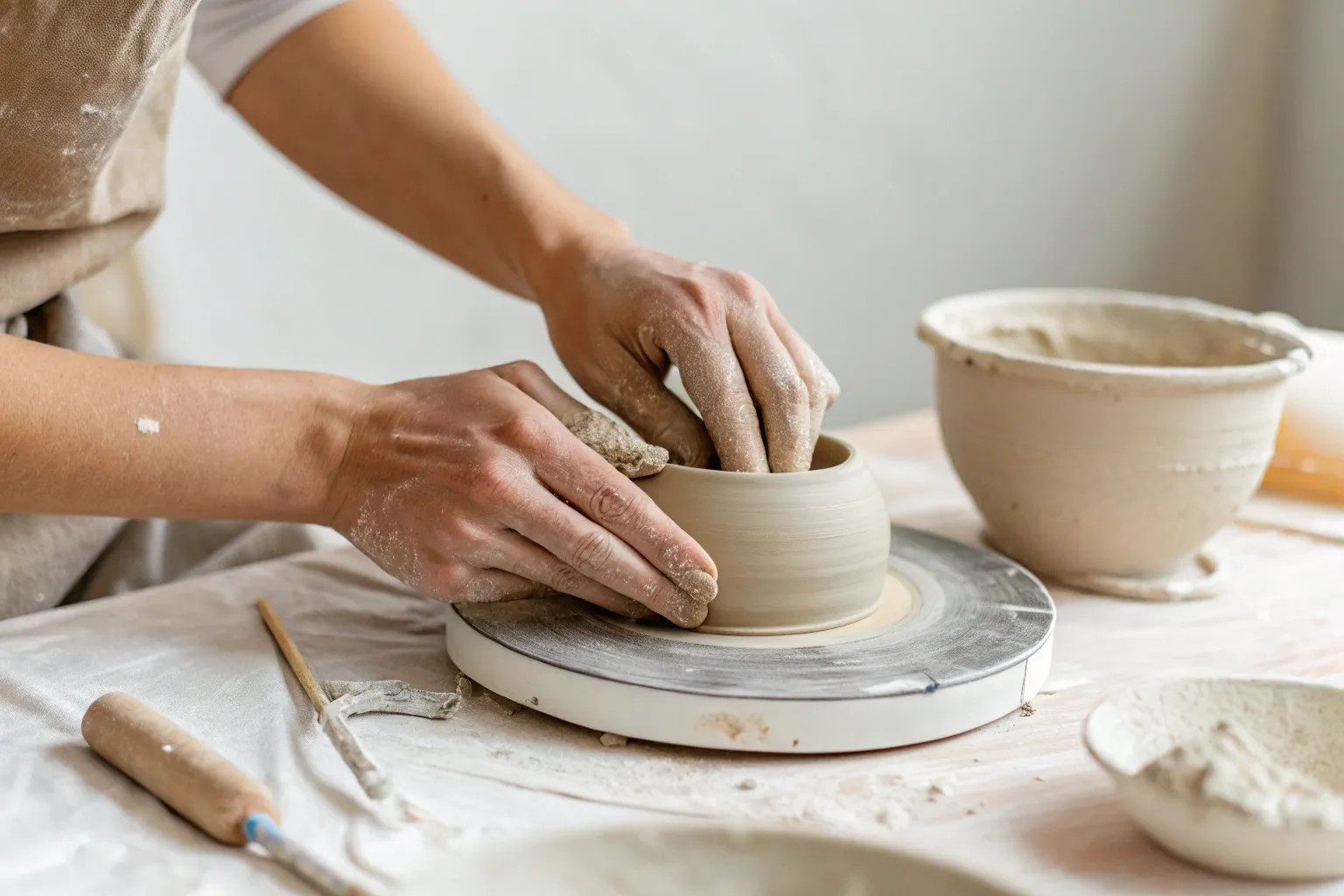Clay holds transformative power—not just as a material, but as a bridge between our inner emotional world and tangible expression. Through the ancient practice of working with earth and water, we can give physical form to the intangible realm of feelings.
The Science Behind Clay and Emotions

Working with clay engages multiple sensory pathways simultaneously. The tactile experience activates nerve endings in your palms—thousands of them—creating direct communication between your hands and brain. This sensory engagement naturally calms the nervous system while providing a non-verbal outlet for emotional processing.
Research demonstrates that clay manipulation reduces cortisol levels within 45 minutes, while the rhythmic, repetitive motions involved in kneading and shaping induce a meditative state similar to mindfulness practices. When we work with clay, we enter what neuroscientists call the “flow state”—a condition where intrusive thoughts quiet and present-moment awareness heightens.
Understanding Your Emotional Palette
Before touching clay, take a moment to identify your current emotional landscape. Emotions rarely exist in isolation; they layer and blend like watercolors on wet paper.
Mapping Your Feeling: Close your eyes and scan your body. Where do you sense tension, lightness, or energy? Is your emotion hot or cool? Does it feel heavy like stone or light like air? Sharp or rounded? These physical sensations will guide your clay work.
I often find that starting with pure sensation rather than naming emotions creates more authentic pieces. A knot in your stomach might translate to twisted clay forms, while a feeling of expansion in your chest could become an opening, unfolding sculpture.
Essential Clay Basics for Emotional Expression
Choosing Your Clay

For beginners, water-based earthenware clay with fine grog provides the ideal balance of workability and structural integrity. This clay remains forgiving while holding detail, allowing for both aggressive manipulation and gentle refinement.
Air-dry clay offers convenience for home studios, though it lacks the transformative fire process that traditional ceramics provide. Polymer clay works well for smaller, detailed pieces but requires oven curing.
Core Hand-Building Techniques
Pinch Method: Begin with a sphere of clay roughly the size of your palm. Press your thumb into the center, stopping about a quarter-inch from the bottom. Rotate the clay while pinching the walls outward, maintaining even thickness. This technique naturally accommodates organic, emotion-driven forms.
Coil Building: Roll clay into rope-like coils of consistent thickness. Layer these coils to build height and volume, joining each layer with a bonding pinch that presses the coil into the existing structure. This method excels for expressing growth, accumulation, or layered emotional complexity.
Slab Construction: Roll clay between wooden guides to create flat sheets of uniform thickness. Cut and join these slabs to construct geometric or architectural forms. This approach works well for contained emotions or structured feelings.
Translating Feelings into Form
Working with Anger

Anger demands physical release. Begin by kneading your clay vigorously—let your hands express the intensity you feel inside. This emotion often translates into sharp angles, torn edges, or explosive forms. Don’t smooth away the texture created by aggressive handling; these marks carry the authentic energy of your feeling.
Consider creating pieces with jagged silhouettes or forms that seem to burst outward. The clay can handle your intensity—push it, twist it, let it crack if needed. These imperfections become part of anger’s visual vocabulary.
Expressing Sadness
Sadness tends to flow downward, like water seeking its level. When working with this emotion, I allow gravity to guide the clay. Create forms that seem to melt or pool, with smooth, rounded edges that echo tears or the weight of sorrow.
Pinch pots work beautifully for sadness—the inward-turning gesture mirrors the introspective nature of grief. Make the walls thin enough to seem fragile, expressing vulnerability through the clay’s delicate structure.
Capturing Joy
Joy radiates outward and upward. This emotion calls for forms that seem to dance or reach skyward. Coil building excels here—stack and twist your coils to create spiraling towers or flowering forms that open toward light.
Add texture by pressing objects into the clay surface—bubble wrap creates tiny circles of light, while fabric leaves subtle cloth impressions. These details catch light and shadow, adding visual movement to your joyful forms.
Embodying Anxiety
Anxiety often feels tangled and restless. Create forms that seem to twist back on themselves or incorporate maze-like channels that lead nowhere. Layer thin slabs at odd angles, or create pieces with internal tensions—forms that seem to push against themselves.
The repetitive nature of detailed surface work can actually soothe anxious feelings while creating visual representations of mental spiraling or racing thoughts.
Step-by-Step: Creating Your Emotional Form
Phase 1: Emotional Preparation (5 minutes)

Sit quietly with your clay still wrapped. Breathe deeply and identify your current emotional state. Don’t judge or analyze—simply observe. Notice where you feel this emotion in your body and how it wants to move.
Phase 2: Initial Contact (10 minutes)
Unwrap your clay and begin kneading. Let your emotion guide the pressure and rhythm. Aggressive feelings might demand forceful manipulation, while gentler emotions call for soft, caressing movements. This warming process makes the clay workable while allowing your hands to begin their dialogue with the material.
Phase 3: Form Creation (20-30 minutes)
Without predetermined plans, begin shaping. Trust your hands to know what to do. If working with anger, you might find yourself creating sharp, angular forms. Sadness often produces drooping or flowing shapes. Joy tends toward upward movement and expansion.
Allow the clay to guide you as much as you guide it. Sometimes the most profound emotional expressions emerge when we collaborate with the material’s natural tendencies rather than fighting them.
Phase 4: Surface Development (10-15 minutes)
Add texture and detail that enhances your emotional expression. Use found objects, natural materials, or simple tools to create surface interest. The bottom of a plastic bottle creates interesting circular patterns, while pressing fabric into clay leaves subtle textile impressions.
Consider how light will interact with your finished piece. Emotions have their own relationship with illumination—some hide in shadows while others bask in brightness.
Phase 5: Refinement (5-10 minutes)
Step back and observe your creation. Does it capture the essence of your feeling? Make any final adjustments, but resist over-working. Emotional authenticity often lies in the imperfect, spontaneous gesture rather than polished perfection.
Surface Treatments and Finishing
Working with Natural Clay

If using traditional clay that will be fired, consider how the firing process might transform your piece. Emotions change over time, and the kiln’s heat can metaphorically represent this transformation. Leave some areas unglazed to show the clay’s natural color—this raw earth connection often resonates with primal emotions.
Air-Dry Clay Options
For air-dry pieces, acrylic paints offer emotional color possibilities. Don’t feel bound by realistic colors—purple skin or blue tears can more accurately represent your inner experience than natural tones. Consider leaving portions unpainted to maintain the clay’s honest, earthy character.
Texture as Emotion
Sometimes the clay’s surface tells the emotional story more powerfully than its form. Smooth surfaces might represent peace or numbness, while rough textures could indicate turmoil or intensity. Use your fingers, natural objects, or simple tools to create textures that amplify your emotional message.
Working Through Different Emotional States
Creating from Depression
Depression often feels like absence rather than presence. When working with this emotion, I focus on creating negative spaces—holes, voids, or hollowed forms that represent the emptiness depression brings. The clay becomes a container for absence itself.
Sometimes depression manifests as extremely smooth, simplified forms that seem drained of energy or detail. These minimal sculptures can powerfully communicate the flattened affect that accompanies this condition.
Expressing Love
Love wants to embrace and connect. Create forms that seem to reach toward each other or intertwine. Two separate clay forms that relate across space can express love’s connection between distinct beings. Consider pieces that literally hold or cradle other objects, embodying love’s protective, nurturing aspects.
Embodying Fear
Fear contracts and hides. Create forms that curl inward or seem to shrink away from touch. Spiky, defensive surfaces can represent fear’s protective mechanisms. Sometimes fear creates forms that seem incomplete—as if they’re pulling back before full expression.
Advanced Emotional Expressions
Combining Emotions
Real emotional life rarely involves pure, single feelings. Create pieces that express emotional complexity by combining techniques or creating forms that transition from one emotional state to another. A piece might begin angular and aggressive but flow into smooth, peaceful curves, representing the journey from anger to acceptance.
Seasonal Emotions
Consider how different times of year affect your emotional landscape. Winter pieces might feel more introspective and contained, while summer expressions could be more expansive and energetic. Let the current season inform your choice of forms and surface treatments.
Emotional Memory
Sometimes we create not from present feelings but from emotional memories that need expression. These pieces often carry different energy—they might feel more distant or nostalgic. Trust the clay to hold these memories and give them appropriate physical form.
Troubleshooting Common Challenges
When the Clay Feels Wrong
If your clay becomes too soft, let it rest uncovered for 10-15 minutes to firm up. If it’s too stiff, mist lightly with water and knead gently. Remember that clay’s consistency affects emotional expression—soft clay might better serve fluid emotions while firmer clay works well for structural feelings.
When You Feel Stuck
Step away for a few minutes. Sometimes emotional clarity needs breathing room. When you return, approach your piece from a different angle—literally. Walk around it, view it from above or below. New perspectives often unlock creative solutions.
When the Emotion Changes
Let it. The clay can hold multiple emotional states or transform as your feelings shift. Some of my most meaningful pieces began as anger and ended as sadness, or started with fear and evolved into determination. Allow your piece to be a record of emotional journey rather than a snapshot of a single moment.
Caring for Your Emotional Sculpture
Immediate Care
Keep unfinished pieces wrapped in damp cloth or plastic to maintain workability. Emotional work often spans multiple sessions, so preserve your clay’s plasticity between working periods.
Long-term Preservation
Air-dry pieces benefit from a light sealant to prevent dust accumulation and minor damage. Traditional fired pieces become permanent records of your emotional state—artifacts of feeling that can provide insight and comfort for years to come.
Displaying Your Work
Consider how and where you’ll display your emotional sculpture. Some pieces want private space for personal reflection, while others might benefit from natural light that emphasizes their surface textures. Trust your instincts about whether a piece wants to be seen or held in quiet contemplation.
Building Your Emotional Clay Practice
Regular Sessions
I recommend weekly clay sessions of 45-60 minutes. This consistency allows you to track emotional patterns and develop increasingly sophisticated ways of expressing complex feelings. Keep a simple journal noting the emotions that emerged during each session.
Seasonal Reviews
Every few months, arrange your completed pieces and observe patterns. Do certain emotions recur? How has your expression evolved? This practice builds emotional intelligence while creating a physical record of your inner journey.
Sharing Your Work
Consider sharing selected pieces with trusted friends or family members. Often, others can see emotional truths in our clay work that we might miss. Their observations can deepen your understanding of both your emotions and your artistic expression.
Working with clay provides a uniquely powerful way to explore and express our emotional landscape. Through the honest dialogue between hands and earth, we create not just sculptures but insights—tangible records of our inner lives that can guide us toward greater emotional awareness and authentic self-expression. Each piece becomes a milestone in the ongoing journey of understanding who we are and how we feel, preserved in clay for future reflection and growth.

